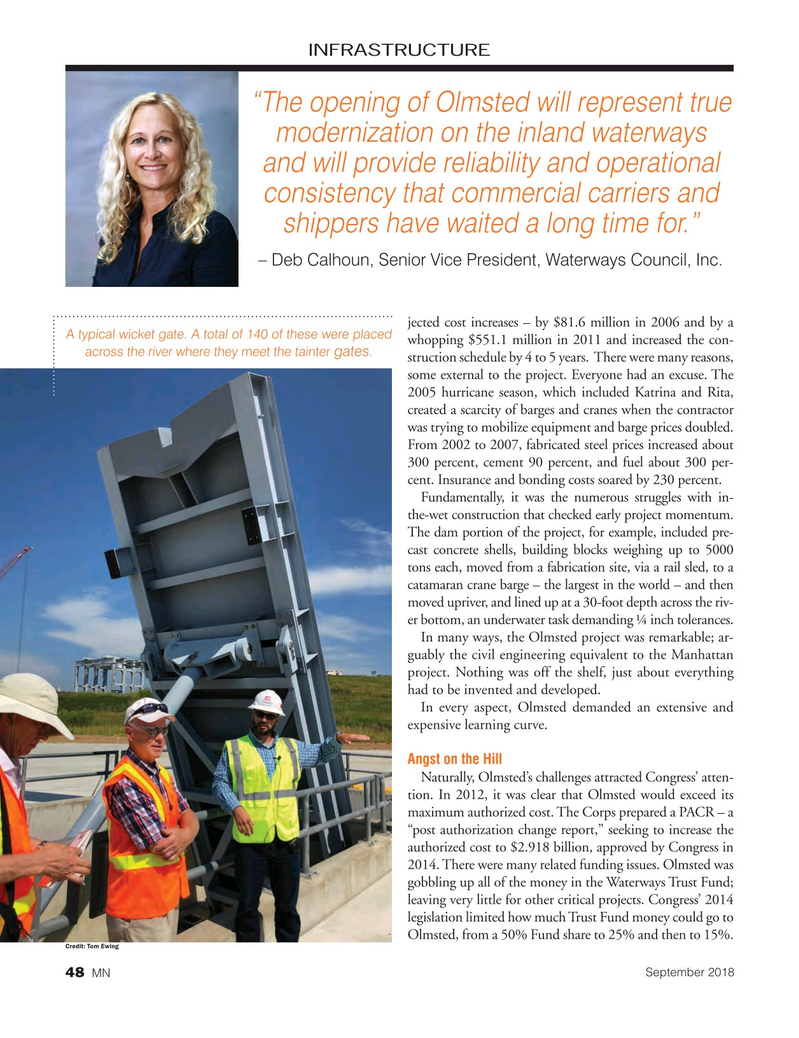
Page 48: of Marine News Magazine (September 2018)
Offshore Annual
Read this page in Pdf, Flash or Html5 edition of September 2018 Marine News Magazine
INFRASTRUCTURE “The opening of Olmsted will represent true modernization on the inland waterways and will provide reliability and operational consistency that commercial carriers and shippers have waited a long time for.” – Deb Calhoun, Senior Vice President, Waterways Council, Inc.
jected cost increases – by $81.6 million in 2006 and by a
A typical wicket gate. A total of 140 of these were placed whopping $551.1 million in 2011 and increased the con- across the river where they meet the tainter gates.
struction schedule by 4 to 5 years. There were many reasons, some external to the project. Everyone had an excuse. The 2005 hurricane season, which included Katrina and Rita, created a scarcity of barges and cranes when the contractor was trying to mobilize equipment and barge prices doubled.
From 2002 to 2007, fabricated steel prices increased about 300 percent, cement 90 percent, and fuel about 300 per- cent. Insurance and bonding costs soared by 230 percent.
Fundamentally, it was the numerous struggles with in- the-wet construction that checked early project momentum.
The dam portion of the project, for example, included pre- cast concrete shells, building blocks weighing up to 5000 tons each, moved from a fabrication site, via a rail sled, to a catamaran crane barge – the largest in the world – and then moved upriver, and lined up at a 30-foot depth across the riv- er bottom, an underwater task demanding ¼ inch tolerances.
In many ways, the Olmsted project was remarkable; ar- guably the civil engineering equivalent to the Manhattan project. Nothing was off the shelf, just about everything had to be invented and developed.
In every aspect, Olmsted demanded an extensive and expensive learning curve.
Angst on the Hill
Naturally, Olmsted’s challenges attracted Congress’ atten- tion. In 2012, it was clear that Olmsted would exceed its maximum authorized cost. The Corps prepared a PACR – a “post authorization change report,” seeking to increase the authorized cost to $2.918 billion, approved by Congress in 2014. There were many related funding issues. Olmsted was gobbling up all of the money in the Waterways Trust Fund; leaving very little for other critical projects. Congress’ 2014 legislation limited how much Trust Fund money could go to
Olmsted, from a 50% Fund share to 25% and then to 15%.
Credit: Tom Ewing 48 MN September 2018
MN Sept18 Layout 32-49.indd 48 MN Sept18 Layout 32-49.indd 48 8/27/2018 4:19:53 PM8/27/2018 4:19:53 PM

 47
47

 49
49
